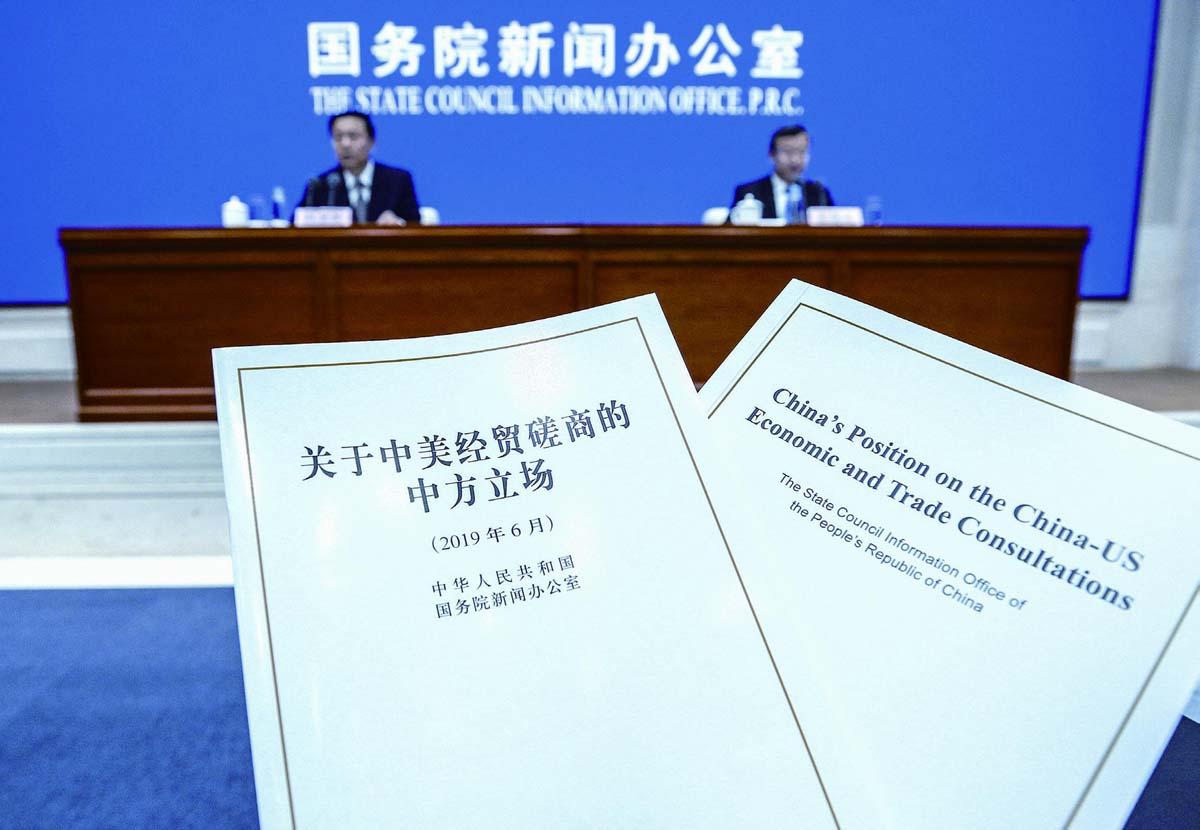A CLEAR STANCE
2019-09-09ByAnGang
By An Gang

In a white paper issued by the State Council Information Office on June 2, China made it clear that the U.S.-initiated economic and trade friction damages the interests of both countries and of the wider world. The paper, titled Chinas Position on the China-U.S. Economic and Trade Consultations, also revealed that the U.S. backtracked three times on its commitments during bilateral consultations. It reiterated that China is committed to credible consultations based on equality and mutual benefit. As part of our coverage of the ongoing trade friction, Beijing Review asked Chinese experts to comment on the document and the latest developments.
Sino-U.S. trade negotiations took a sharp downturn at the beginning of May. The Donald Trump administration accused China of “breaking the deal” reached before and increased tariffs on Chinese goods worth $200 billion from 10 percent to 25 percent. Moreover, the U.S. Trade Representatives Offi ce is currently taking public comments on another tariff hike on $300 billion worth of Chinese goods, which could go into effect as early as late June.
Coupled with trade friction is the intensifi ed U.S. suppression of Chinese technology industries. On May 15, Trump signed an executive order declaring a national emergency and prohibiting all U.S. enterprises from using telecommunications equipment made by companies that are deemed a threat to national security. This was a substantial step toward cutting off the supply chain between Chinese telecommunications giant Huawei and its U.S. customers. Thus, the U.S., armed with trade friction and a “technology war,”has unleashed cutthroat competition against China.
Facing mounting and aggressive pressure from the U.S., China responded with a combination of countermeasures. It slapped duties of 10 percent, 20 percent and 25 percent on different U.S. goods worth $60 billion starting on June 1. In addition, the Ministry of Commerce announced on May 31 that the Chinese Government will establish a list of unreliable entities. Foreign enterprises, organizations and individuals that do not comply with market rules, violate the spirit of contracts, block or cut supplies to Chinese firms with non-commercial purposes, and seriously damage the legitimate rights and interests of Chinese enterprises will be added to it.
As the worlds largest producer and supplier of rare earth minerals, key components of smartphones, jet engines and cameras, China could cut off supplies that are needed by huge swaths of the U.S. economy if it fi nds it necessary. An offi cial with Chinas National Development and Reform Commission made it clear that if anyone were to use products that are made with the rare earth minerals that China exports to curb Chinas development, the Chinese people would not be happy.

It is clear that Chinas countermeasures aim to defend it. “China is open to negotiations, but will also fi ght to the end if needed,” stated a recently issued white paper titled Chinas Position on the China-U.S. Economic and Trade Consultations. “China will act rationally in the interests of the Chinese people, the American people, and all other peoples around the world,” it continued. “Guided by a spirit of mutual respect, equality and mutual benefit, the two countries should push forward consultations based on good faith and credibility in a bid to address issues.”
Core concerns
Chinese Vice Premier Liu He, also head of the Chinese team during the China-U.S. Comprehensive Economic Dialogue, raised three concerns from the Chinese side after the 11th round of trade talks. In fact, failing to reach consensus on these three concerns was the major reason for the breakdown of this round of negotiations.
First, China called on the U.S. to remove all additional tariffs imposed on Chinese exports. Since these tariffs are the starting point of bilateral trade friction, they should all be lifted when an agreement is reached. Second, Chinas purchase of U.S. goods should be realistic. The U.S. should not ask for high prices or make purchase demands impossible for China to satisfy. Third, a proper balance should be struck in the text of the agreement.
The white paper reiterated Chinas position on these concerns. “Both China and the U.S. should see and recognize their countries differences in national development and stage of development, and respect each others development paths and basic institutions. While no one expects to resolve all issues in one single agreement, it is necessary to ensure that an agreement satisfies the needs of both sides and achieves a balance.”

Going forward, the competition between China and the U.S. will be neither simply about interests nor geo-political gains. Instead, it will be a race between two development models, values and orders. Even if a trade agreement can be reached, it will not be the end of bilateral trade and economic friction, but only the start of a larger-scale and longer-term game.
Strong willpower
The U.S. demands in negotiations are not realistic, including the purchase of U.S. goods far beyond Chinas capability, extensive revision of Chinas domestic laws and acceptance of U.S. supervision and verification. Such requests touch on Chinas core interests. China has to persist in a two-way balance, resist pressure from the U.S. through countermeasures, fight on different fronts such as trade, technology and other fi elds, and accumulate strength. China will also enhance its fundamental research capability for indigenous innovation and nurture the domestic market as it turns pressure into opportunities.
By doing so, it will transform its own development and international cooperation model. In this sense, the trade friction and technology war initiated by the Trump administration are helping forge consensus among the Chinese on the U.S. and giving rise to a strong cohesion for powering the country forward.
As it encounters extensive changes from economic to security areas in both domestic and external arenas, what China needs most is solid willpower and reform momentum. After several rounds of pressure tests, Chinas confidence in coping with the trade friction and its derivatives is recovering. The white paper pointed out,“The fundamental solution to economic and trade tension is to grow stronger through reform and opening up.”

It also stressed Chinas confidence.“With the enormous demand from the domestic market, deeper supply-side structural reform will comprehensively enhance the competitiveness of Chinese products and companies. We still have sufficient room for fiscal and monetary policy maneuvers,” it reassured. “China can maintain sound momentum for sustainable and healthy economic development, and its economic prospects are bright.”
The real problem is that the battle between China and the U.S. on economic and technological fronts is increasingly being translated into restrictions on Chinese companies and products. Even if the confrontational situation is reversed with the conclusion of a trade agreement, the negative impact is not likely to be eliminated. U.S. restrictions on Huawei forced the latters backup chip company to come to the rescue. The ensuing changes in the supply chain, as well as the measures and countermeasures taken, will be long lasting, fueling a decoupling of the worlds two largest economies. As a result, the global industry is gearing up for a fresh global operation model.
